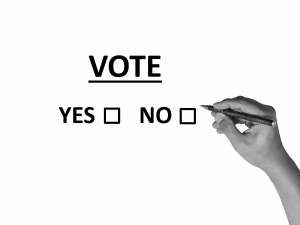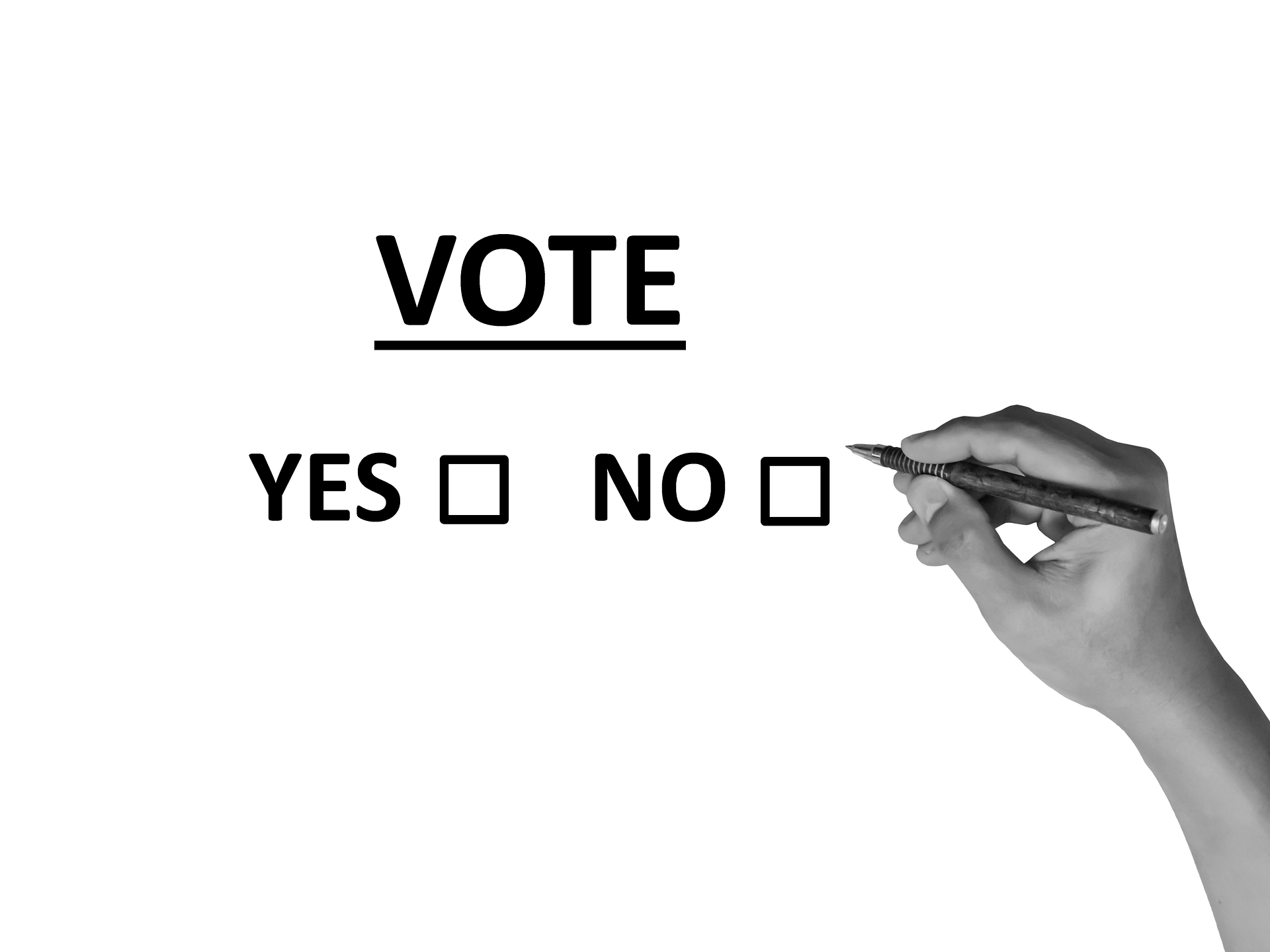We like decisive decision making. However we often see that quick consensus leads to bad decisions. In a team situation, forcing quick consensus can easily lead to taking bad decisions. To avoid this, effective decision makers even organise dissent to improve the quality of their team’s decision making. According to Peter Drucker, “All the first-rate decision makers I’ve observed had a very simple rule:
In my experience of working with management teams, this makes a lot of sense. For two reasons:
- A quick decision probably does mean that options and issues have not been thought about and explored. As a consequence, the decision will get ‘un-picked’ or ‘un-taken’ later in the decision process.
- I often see decisions being brought to a table, as an answer, rather than a question or as an observation and a diagnosis of what is going on. That is, “Here is the problem so we should do this…, do you agree? Let’s vote on it”.

Vote – agree or disagree?
This is an example where the framing and diagnosis of the problem or situation is being omitted, stepped over or has become implicit. Typically this leads to potentially quite different solutions being plausible, but not explored.
So I was curious about the context that Drucker was talking about. So, when I first came across this quote, I decided to look up the original source (Always worth doing).
To reach proper consensus, an effective decision requires dissent
In Management: Tasks, Responsibilities and Practices, Peter Drucker devotes a whole chapter to “The Effective Decision”. In that chapter, Drucker provides an example from Alfred P Sloan at a meeting of one of GM’s top committees. Sloan is reputed to have said,
“I take it we are all in complete agreement on this decision here”. Everyone around the table nodded their assent.
“Then”, continued Mr Sloan, “I propose we postpone further discussion of this matter until our next meeting, to give ourselves time to develop disagreement and perhaps gain some understanding of what this decision is all about”
What Sloan is doing is deliberately looking for dissent and opinions. He is looking for ideas to test against the facts. In Excitant’s six step decision process, he is taking people back from decision taking, to a better understanding of the situation (decision awareness) and deliberately inviting alternative framing and implementation options. He is using dissent to do this. Dissent is a symptom of something more useful: a scepticism and a willingness to look at the decision in more detail.
As Peter Drucker puts it, “The right decision requires the right disagreement”. The right dissent is as much about the process of dissent, as the content of the dissent. It is about the quality of conversation and the quality of decision-making.
“The right decision requires the right disagreement. It is about the process that creates the quality of conversation, quality of thinking, and quality of decision making and decision taking.”
Three reasons why dissent is useful to avoid bad decisions
Drucker describes three reasons why dissent is important and necessary for good and effective decisions. I am going to put them in a different order to Drucker.
First, for me is that it provides options and alternatives.
“We need options and alternatives at each stage of the decision process”
Drucker puts it extremely well, “A decision, without an option, is a desperate gambler’s throw!” Alternatives are important to the process on exploring a decision. Importantly those alternatives, need to apply for each stage of the decision process. So, there can be alternative understanding of the situation, alternative framing and diagnosis of the decision, and alternative options to solve and implement the decision. All are alternatives. All provide tests and useful dissent
Second, Drucker suggests safe-guards the decision maker from becoming a prisoner of the organisation.
“Argued, documented, thought through disagreement, prevents the decision maker becoming a prisoner of the organisaton
What Drucker is referring to here is the special pleading and politics that goes on in an organisation, where people are trying to find favourable decision for themselves. The way to avoid this is to make sure there is ‘argued, documented, thought through disagreement’. It is certainly true that isolated, silo based decision are not helpful. They are typically a poorly framed and diagnosed solution, so I can see where he is coming from.
Third, Drucker suggests that disagreement stimulates the imagination: that leads, eventually to a more creative solution.
“Disagreement stimulates the imagination. It creates a wider view of the problem, and more creative solutions.”
I have seen this in action so often in strategy workshops. One example I talk about where a management team come up with nine different diagnosis within 30 minutes, is a superb example of this. Their initial diagnosis and leap to a solution would have being uncreative and engage no-one’s imagination. The process of creating a wider view of the problem and its sources unleashed all sorts of more imaginative conversations and therefore more potentially creative solutions. The disagreements, or in this case the alternative diagnoses acted to create a better set of options.
The effective decision maker organises dissent
So where are we left? Well it sounds unlikely, but a really effective decision maker is not trying to create consensus. He or she is first trying to create dissent.
Or rather, they are trying to create dissent initially so that there is a better quality of conversation and decision-making that will lead, to a more imaginative approach and eventually, through to a more effective decision where there is genuine consensus.
“Dissent is encouraged to improve the quality of conversation, thinking and overall decision making. To reach genuine consensus”
What is important here is that consensus should be approached obliquely. Try to go straight there, “Ladies and gentlemen, I think we all agree…” and you will not get a good decision that remains taken. Approach it obliquely, “We do not have enough dissent and alternative views here. Go away and think more deeply about this, so you have a proper argument!” actually leads to better decisions. (Often I tell my clients that the purpose of the strategy workshop is to create some arguments: arguments that will ultimately improve the quality of conversation. Afterwards, they say that the conversations – arguments – were refreshing and it was good they had them.)
Conclusion
Three recommendations to promote more effective decision-making:
- When you see tacit agreement, beware! Effective decision-making requires dissent, disagreement and a robust conversation. It should be encouraged rather than suppressed.
- Aim for dissent and disagreement, or at least imaginative options, BEFORE you aim for consensus.
- Make sure your teams know that this is how you want decisions discussed and explored. A though understanding of the situation, how it is seen and diagnosed, opinions as well as alternative solutions.
Together these will help you improve the quality of your conversation and the quality of your decision-making and decision taking.
To find out more have a look at our six step decision process, or if you want to improve how your teams make, take and learn from their decisions, then get in touch.



Trackbacks/Pingbacks